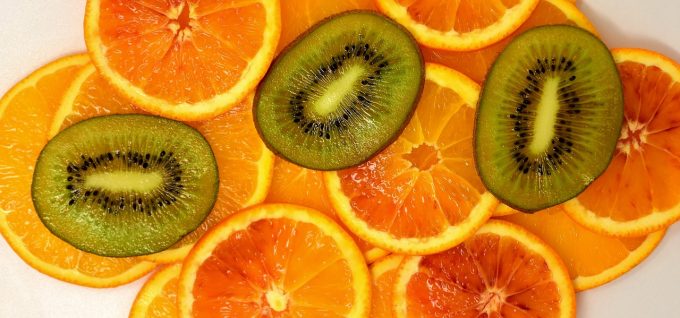I’m currently at the beautiful, seaside Regency Health Resort and Spa in Hallandale Beach, Florida, where I’m a speaker for the National Health Association‘s annual conference. When I arrived on Friday in the mid-afternoon, having had some carry-on food on the plane, but nothing really enlivening, I checked out the Regency’s dining area and found that, although it was between mealtimes, there was a bountiful bowl of washed romaine lettuce. I took a hefty bunch of it and munched contentedly. It was the completion of my lunch and made one that would have otherwise seemed not enough, or just not right, absolutely perfect. I learned in that moment that while some people’s idea of luxury might be a yacht or multiple homes, mine is coming in from a trip or a day of running errands and finding lovely romaine leaves washed and dried and waiting for me. The experience prompted me to share with you this excerpt called “Enliven Your Diet” from my book Living a Charmed Life: Your Guide to Finding Magic in Every Moment of Every Day © Victoria Moran 2009, published by HarperOne, all rights reserved.
The essence of any charmed life is energy. This energy—the life force that the yogis call prana and that martial artists and traditional Chinese doctors call ch’i—inspires your best thinking and propels you toward your goals. Its magnetism attracts the best of life to come to you via other people and well-disposed coincidence. During our lifetimes we operate with greater and lesser degrees of this life force. It’s heightened when our stress levels are low, when we’re taking good care of ourselves, and when we’re happy. We increase our reserves by sleeping well and on a regular schedule; breathing deeply of clean, fresh air; and ingesting prana via the foods we eat. The foods that have the highest level of this subtle but vital energy are those that are alive.
Don’t panic: I’m not suggesting that you join some insect-munching cult. By living food, I’m talking about fresh fruits and vegetables and juices made from them, and sprouts, nuts and seeds, all of them uncooked, organic and locally grown when possible. Fruits and veggies, before they’ve been subjected to heat or processing, are repositories of life force that is transferred to you when you eat them.
Some people eat these foods exclusively and the “raw-fooders” I know appear to be in excellent health. I’m not suggesting that you take it that far, but if you can get to the point at which even fifty percent of the food you eat is in this category, your energy will soar. If you make it to seventy-five percent, you won’t recognize yourself.
Nutritionists agree that raw produce is bursting with vitamins, minerals, and the phytochemicals believed to protect against degenerative disease. People who espouse the benefits of eating “high raw” sing the praises of enzymes, present in fresh foods but destroyed when subjected to cooking temperatures over 115 degrees. They claim that we’re born with an enzyme reserve but we deplete it digesting cooked foods, which have no enzymes of their own. When we eat raw foods—fruits, salads, freshly extracted juices—they contain the enzymes needed for their own digestion and some to spare.
When making the transition to a high-raw diet, it is possible to experience detoxification symptoms, such as transient headaches and fatigue. It is three positive changes, however, that most people notice almost immediately. First, if I may say this delicately, elimination improves. (Take my word here: it really improves.) Next comes a heightened energy level. Within a few days, it’s as if the weight of the world is off your shoulders (or at least out of your stomach). And finally, you look better. In addition to losing some weight (which will absolutely happen), it doesn’t take long to get the fabled “raw food glow” earmarked by brighter eyes, clearer skin, and that infectious energy. When my now-grown-up daughter, Adair, was still living at home, we used to do two weeks of raw food every summer. One of her friends asked why we did it and she said, “Because everybody deserves to be gorgeous two weeks a year.”
If you’re willing to give this a whirl, here’s what you need to know to get started on the path to eating half (of more) of your food in the blissful state of alive and well:
Suggestions for an Enlivened Diet and a Livelier You
Start the day fresh. If you have a juicer, the best first “meal” is fresh juice made of greens of your choice (I like romaine and kale), some apple or pineapple to make it tasty and sweet, and a little lemon and/or fresh ginger for some wake-up punch. Many people do beautifully on fresh juice first thing and fruit throughout the morning. If you want a heavier breakfast (or if you like your coffee), have these at least half an hour after your green juice.
Blend enlivening elixirs. Smoothies are a tasty, easy way to get more live foods into your diet. Use a base of water, fresh juice, or “nut milk”—1/4 cup raw hazelnuts or cashews blended with ten ounces of water and strained. Then add a banana (or two) and fresh or frozen berries. For a nutritional boost, make a “green smoothie” by tossing in some greens, such as romaine, spinach, or kale. They’ll change the color but not the taste of your shake, and your body will be overjoyed to get them.
Create super-salads—and shoot for two a day. Many of us have been conditioned to think of salad as something “on the side” or the item of choice when you don’t want to be seen ordering the Philly cheese-steak. But a salad can be a delicious and hearty mélange of flavors and textures. Choose a base of romaine, leaf lettuce, baby greens, spinach, arugula, or some combination, and add sprouts, tomatoes, carrot, radishes, cauliflower, cilantro—whatever looks yummy at the farmers’ market. Give a salad soul-satisfying substance with crunchy sunflower or pumpkin seeds, chewy sun-dried tomatoes or cranberries, or spicy kimchee (Korean sauerkraut). Or opt for a cooked addition such as lightly steamed broccoli or steamed potato chunks, red beans, or garbanzos. (You can also blend salad ingredients with some water and appropriate seasonings—lemon pepper, basil, dill, a little sea salt—for soup. Avocado makes it creamy.)
Learn a few raw recipes. Although seasoned devotees usually eat simply, there is a whole world of live-food cuisine to tantalize the palate and give those who enjoy the culinary arts a new forum for their creativity. A properly wielded mandolin (thin-slicer) or a sharp vegetable peeler can turn zucchini or a fat carrot into ribbons (like pasta) that are yummy with a marinara made from ripe tomatoes, garlic, onion, and fresh basil. With a dehydrator, you can make crackers, crepes, pizza crust, and other ersatz wonders. For now, just learn to make a couple of simple salad dressings, soups, and desserts. You’ll feel like a pro.
Bring on the reinforcements. Because we live in a cooked-food world, you may want to carry some raw food with you. Raw flax crackers (these can made with a dehydrator or purchased at a health food store) help when the breadbasket is going around the table. A raw candy bar (some combination of dried fruit and nuts) in your bag means that when you meet a friend at the coffee place and she’s enjoying a monster muffin, you can have a yummy treat, too.
Don’t get cold. During the winter, make your salads from room-temperature ingredients instead of right-out-of-the-fridge, and leave the frozen fruit out of your smoothies. Heat your raw soups a little by using warm water in the recipe or gently heating the soup in a double-boiler (use a kitchen thermometer to be sure you don’t go over 115 degrees). Even committed raw-fooders, if they tend to the cold side, often drink tea—antioxidant green tea, perhaps, or a tasty herbal such as licorice—when it’s cold outside or somebody has cranked the a/c up to high.
Go “Live till 5.” This little slogan helps many a high-raw eater stick with fresh raw foods during the day while leaving them free to enjoy a combination of raw and cooked foods for dinner.
As with any new undertaking, educate yourself. There are a plethora of books, DVDs, websites, and YouTube flicks offering information, recipes, and support. Take advantage of them. You deserve to be gorgeous, and to have ample energy for a very charmed life.
Victoria Moran, CHHC, AADA, VLC, is a certified holistic health counselor and vegan lifestyle coach with a private practice in New York City and telephone clients around the world. She is also the Oprah-featured author of ten books including Lit from Within, Fit from Within, Younger by the Day, The Love-Powered Diet, and Living a Charmed Life, from which the above was excerpted.

